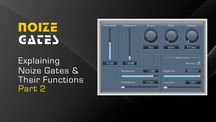Following on from Noise Gates Explained Pt1 where we provided an introduction to Noise Gates and two situations in which they could be most beneficial, in this post we'll look at the basic parameters of a gate and their definitions.
Almost every gate includes the following set of parameters: Threshold, Attenuation amount (range), Atttack, Hold, and Release.
The diagram above shows these parameters in context.
If you read our recent posts on compression, these settings will be familiar to you so you might be thinking, "what's the difference between a Gate and a Compressor then". The fundamental difference is in when they act on a signal. Compressors act when a signal exceeds your set threshold to help reign in your louder sounds. A Gate acts when a signal is below your set threshold by "gating" or attenuating the quieter sounds either partially or fully depending on your settings.)
Threshold
The threshold parameter determines the volume below which the signal will be attenuated. That is, when the signal drops
Attack time
This is the time it takes for the gate to fully open once the signal passes your set threshold level. Sounds exceeding your threshold are the sounds you are wanting to let through the Gate.
Lowest available attack times would be in the 10-100 us (microsecond) range depending on the unit, while maximum attack times vary considerably depending on manufacturer and model, but would go anywhere from 200 ms (milliseconds) to 1 second. Fast times may create distortion artifacts, as they modify the waveform of low frequencies, which are slow. On the other hand, a time that is too long will remove the percussive transient from a drum sound. In general, you should set your attack time as fast as possible so that you let sounds exceeding your threshold through the Gate without causing any unnecessary distortion or clicking.
Release time
Release is also sometimes referred to as Decay time. It is the opposite of Attack time, so it's the time it takes the Gate to close once your signal level drops below your set threshold. The release times available on a unit are a lot slower than attack times and may range from 2-10 ms to 3-5 seconds.
Hold
Since the dynamics of even a sustaining note can vary slightly, the hold parameter allows the gate to remain open at full volume for a specific duration after the threshold is crossed, ignoring those subtle variations.
With the hold value set to zero, gating can sometimes create undesirable “chattering” effects when the threshold is set too close to the signal’s lowest volumes.
Sidechain
Without a sidechain function, the gate is a largely utilitarian tool – useful, but not particularly glamorous. You might use it in this instance to simply remove low level background noise in a recording, or use a gate on your vocals to strip the small breaths or sounds between pauses as you speak.
However, add a sidechain and the gate becomes one of the coolest toys in an electronica producer’s arsenal.
Here’s why.
As with the compressor, a sidechain allows a second signal to determine when the gate opens and closes.
So, you could take a sustaining signal like pads or vocals, then use a drum loop as the sidechain input.
This screenshot (above) from Ableton Live shows a gate configured with its sidechain controlled via a track that contains drums. In this instance, every time a drum crosses above the threshold, the sustaining part is heard (because the Gate is open above the set threshold). Between drum hits, the sustaining sound is Gated as the side chain signal drops below your threshold. The end result is that the sustaining sound pulsates in perfect time with the drum loop.
Adjusting the sidechain gain and/or gate threshold can fine-tune the results so that only the loudest drum hits open the gate – or vice versa. Tinkering with the attenuation, attack, hold and release parameters will modify the overall character of the gating, with effects ranging from a slight rhythmic quiver to “chopped up” audio.
For even more precise control – if your sequencing software allows it – you can use a softsynth’s channel as a sidechain input. This means, every time you play a note on the designated softsynth, the gated sound will be heard.
This will allow you to sequence more complex, tightly controlled rhythms than a drum loop permits.
Another useful application might be when you have two beats layered and the layered one is slighly flamming with the other. Sidechaining gating one to the other means that both beats will only be heard when the beat you've chosen as your sidechain input opens the Gate, effectively locking the two together.














